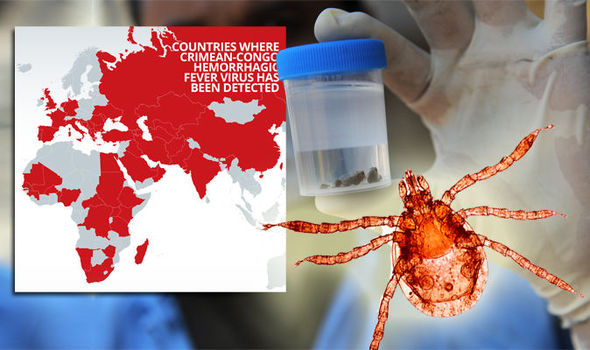Deadly virus sweeps through Europe, Africa, Middle East
A lethal virus running riot across Europe, Africa and the Middle East which is feared to be the biggest threat to the public could soon be found on Britain’s shores. The virus known as Crimean-Congo Haemorrhagic Fever (CCHF ) broke out in Iraq and Namibia, moreso, there have been cases in Spain as well as […]

Crimean-Congo Haemorrhagic Fever
A lethal virus running riot across Europe, Africa and the Middle East which is feared to be the biggest threat to the public could soon be found on Britain’s shores.
The virus known as Crimean-Congo Haemorrhagic Fever (CCHF ) broke out in Iraq and Namibia, moreso, there have been cases in Spain as well as deaths recorded in Pakistan. An urgent health warning has already been issued in what has been described as the current biggest threat to public health and is feared to be accelerated by climate change.
Spread through ticks, the disease is caused by Nairovirus and according to the World Health Organization (WHO) it has a fatality rate of between 10 and 40 per cent. Last week, insiders speaking to Parliament’s Science, Innovation and Technology Committee revealed it was “highly likely” there could soon be cases in the UK.
During the hearing, James Wood, head of veterinary medicine at Cambridge University, said CCHF could find its way to the UK “through our ticks, at some point”. The disease is feared to be expanding out of its usual territories and moving towards the likes of Britain and France because of climate change.
Trials of Coronavirus vaccine makers begin in Germany
‘Ponmo dangerous for now’, FG raises alarm over deadly virus outbreak
Symptoms of CCHF
Among the virus’ symptoms include headaches, high fever, back and joint pain, stomach ache, and vomiting. Red eyes, a flushed face, a red throat, and petechiae (red spots) on the palate are also common.
In severe cases, WHO warns, jaundice, mood swings and sensory perception are encountered. As the illness progresses, large areas of severe bruising, severe nosebleeds, and uncontrolled bleeding at injection sites can be seen, beginning on about the fourth day of illness and lasting for about two weeks.
In documented outbreaks of CCHF, fatality rates in hospitalised patients ranged from nine per cent to as high as 50 per cent. The long-term effects of CCHF infection have not been studied well enough in survivors to determine whether or not specific complications exist. However, recovery is slow.
Source: Mirror.co.uk
